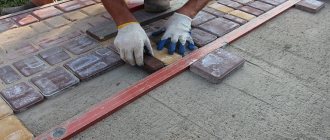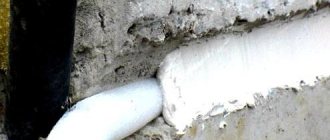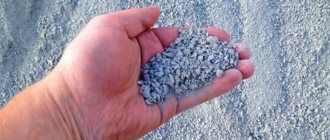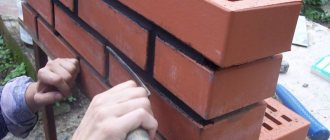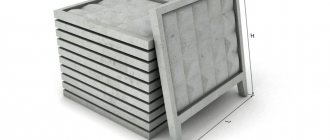Why do cracks appear in asphalt?
The main and inevitable cause of defects in the road surface is sudden changes in ambient temperature, as a result of which moisture entering faults either increases in volume when it freezes, or thaws if it gets warmer outside. Due to weather changes, the destruction of asphalt occurs continuously, and all defects that appear in the coating turn into potholes and pits that are dangerous for transport within a short time.
Fixing them costs much more than repairing minor damage - so it is better to prevent serious defects from appearing, and to repair the smallest cracks as soon as they appear.
Repairing cracks in asphalt pavement
If we consider the road surface system as a living organism, then the cracks in the asphalt will act as foci of infection, which, without proper “treatment,” will slowly begin to undermine the entire organism and deplete more and more of its resources. As you know, roads are one of the “hot” three most pressing Russian problems. Its source in 90% of cases lies in poor service, poor quality and untimely repairs. As people say, “The miser pays twice.” So it turns out that in the pursuit of savings, roads patched ten times over, like a poor man’s bag, are destroyed, and in the end, repairs of cracks in the asphalt pavement are still required, which is much more expensive than partial repairs, but done on time. Let's talk in more detail about the causes of cracks and how to repair cracks in asphalt.
Types of cracks
There are three types of cracks:
- longitudinal,
- transverse,
- mesh.
The latter arise due to exposure to aggressive environmental conditions. This low level of pavement protection from the elements is usually caused by long-term use of asphalt and its “aging”. “Old” asphalt is covered with them in the same way as the skin of an aged person becomes covered with wrinkles.
Often, longitudinal cracks do not appear one at a time; they quickly find a “mate” and spread across the surface, like an infection.
Quite often, such cobwebs form on personal plots and in asphalted courtyards of private houses. Here the reason is completely different: the asphalt is not subject to the loads necessary to maintain its “elasticity”. Accordingly, the coating, without use, begins to “decrepit” in the literal sense of the word. The occurrence of longitudinal cracks is usually caused by violations of the manufacturing technology of the top layer of asphalt concrete mixture or its improper filling.
Constant temperature changes only aggravate the situation and turn repairmen’s mistakes into a real disaster. A large network of intricate interweavings of longitudinal and transverse cracks arises due to a combination of negative factors. Edge straight or crescent-shaped cracks along the side of the road occur due to the delamination of a certain part of the asphalt. The reason may be ground movement, shrinkage, or improper repairs in which the new coating was laid with errors.
Advice: to avoid such “asphalt disease” you need to use only high-quality materials and take into account all the nuances of the pavement laying process.
What causes cracks in asphalt?
The reason for such a defect may lie in an error made at any stage of road construction. Moreover, the earlier a mistake was made in the process, the more difficult it will be to locally eliminate its consequences.
- Incorrectly conducted geological exploration. Before laying a road, the area must be studied by geologists. Particular attention is paid to the soil and its characteristics. Improper soil preparation will result in movement and settlement. Accordingly, the road will “walk” under your feet, and not a single asphalt can withstand this, and it’s good if the matter is limited to only cracks.
- Incorrectly laid foundation. The second stage of construction after exploration and design can also lead to catastrophic consequences. If the wrong slope was chosen or the base was improperly compacted, the coating will certainly settle after a short period of use. The main problem with such a mistake is that even after replacing the old cracked top layer with a new one, no one can guarantee that it will not suffer the same sad fate.
- Failure to comply with the conditions for laying the top layer. The asphalt concrete mixture must be at a certain temperature, unless of course we are talking about the so-called “cold asphalt”. If the temperature of the mixture drops below 120 degrees, then it is a priori considered defective and cannot be used. The temperature regime must be maintained in special “tanks” of equipment for transporting ABS. Their design resembles ordinary household thermoses. In this case, the ambient temperature must also be taken into account: in the cold season it is better to use “cold” asphalt concrete. It will not only “fit” better, but will also protect the base coating from sudden temperature changes. Otherwise, such a patch will become the source of a whole network of cracks later. A poorly prepared base will also have a negative impact on the future fate of such coating. You cannot lay asphalt in the rain. Water in this case is the worst enemy of road surfaces.
- Violations of the ABS “preparation” technology will also affect its quality. All its components must be properly prepared: sand and crushed stone are thoroughly washed, and bitumen and mineral powders are properly selected. Low quality raw materials naturally also cannot become the basis for strong and durable material.
- Freezing of water in the “pores” of asphalt . Hot asphalt concrete pavement, which is used in 90% of domestic roads, has a porous structure. When water stagnates and the temperature then drops to zero, the water in the clogged pores freezes. Everyone knows that the distance between water molecules is increasing and the pressure with which it searches for “free space” is colossal and is capable of breaking even metal pipes or stone blocks. Naturally, asphalt cannot withstand such a load.
Advice: in most cases of crack formation, the human factor is to blame. However, although nature does not have bad weather, sometimes it is climatic conditions that cause such a deplorable situation. And even here, quite often the road surface is simply not designed to withstand such aggressive environmental behavior, although it can be “strengthened” and protected properly during road construction.
What methods can be used to repair cracks in asphalt pavement?
Pit method
The most common method of repairing roads with cracks is patching. Before repairing cracks in the asphalt pavement, it is prepared: defective areas are outlined. Pieces of asphalt are cut out with a special cutter, and it is important to touch not only the upper, but also the lower layers. The bottom of the resulting pit is thoroughly cleaned of crumbs, dust and debris. Then it is filled with hot bitumen emulsion and the asphalt concrete mixture is laid on top. Next, the area is compacted using manual vibrating plates.
This type of repair is considered the most common and cheapest. The only drawback of the technology is that pothole repair does not ensure sealing of the coating.
Jet-injection method
This method is cheap, but it is selective and is suitable only for those sections of the road that are not subject to heavy loads. Cracks are cleaned using a special device that pumps compressed air. Then the inner surface of the defect is treated with bitumen emulsion and filled with crushed stone. For fixing, crushed stone is also “impregnated” with the emulsion and compacted. The measure, of course, is quick and convenient, but is considered only as a temporary one, since after a certain period the cracks will still make themselves felt.
Method using cast asphalt concrete
The stage of preparing the coating for repair work is exactly the same as for simple pothole repair. The only difference: if there is a recycler, the removed layer of asphalt is recycled and reused. They fill the hole with it, compact it and pour cast asphalt concrete mixture on top. There is no need to compact this material. If the repair is carried out on a dangerous section of the road, to increase the adhesion of the patch to the tires, it is immediately sprinkled with black crushed stone and pressed into the coating.
Filling cracks with various types of polymers
The method is very effective: cleaned cracks are hermetically sealed with a special compound that will no longer allow water to pass through and will prevent further destruction of the coating, but such materials are usually expensive, so not every utility office can afford such a luxury.
Advice: any of the above methods can temporarily or permanently correct flaws in the top layer of the road surface, but are completely powerless in the case of foundation laying errors or soil defects. Only complete repair of the road surface and its replacement will help here.
Afterword
As an additional measure, a wear layer is also applied to the top main layer of asphalt using casting technology, which performs the protective function of the coating. It is precisely capable of providing sealing and preventing water from entering the asphalt “pores”. This addition is optimal for those types of repairs that cannot hermetically “clog” the crack. By the way, not all types of cracks can be repaired locally.
The “mesh” on old asphalt cannot be “treated” by any of the above methods; it can only be removed along with the coating, replacing it with a completely new one. It’s exactly the same story with crescent-shaped cracks and defects “along the edge” at the very curb. Here we are talking about tearing one layer of coating from another, and pouring polymer or applying a patch in this situation is the same as “poulticing a dead person,” as our people say. You should treat cracks as the first warning signs of a “disease” and quickly get rid of them, so that you don’t have to spend your entire budget on “treating” seriously damaged asphalt.
What materials are needed to repair cracks?
Various materials are used to repair cracks in asphalt pavement:
- Asphalt concrete mixtures (filling and binding, cold and hot, etc.);
- Bitumen – its advantages include low price and high strength. But in order for the repair of cracks with bitumen to be of high quality, it is necessary to heat it to a high temperature, and in addition, dry the crack well;
- Emulsions (they do not need to be heated; in addition, emulsions are not afraid of moisture and have low viscosity - which means they fill the crack well). Emulsions are usually made from bitumen;
- Sealants are the most suitable material for eliminating defects, because they have optimal viscosity and moisture resistance parameters. However, sealants have a high cost, and therefore are used to a limited extent, in the most critical areas of the road surface;
- Sand is an inexpensive material necessary to protect the fault from excessive heating in the heat. In addition, sand effectively prevents the upper sticky layer of bitumen, emulsion or sealant that fills the crack from sticking to the wheels of cars.
Sealing cracks in asphalt concrete pavements
Scope of work
When sealing cracks using ZT grade filler
based on asphalt distributor
1. Filling tanks with organic binder. 2. Loading materials into bunkers (sand, crushing screenings). 3. Heating the binder and checking the hoses. 4. Installation and removal of fences. 5. Cleaning the coating and cracks from dust and dirt. 6. Filling cracks with organic binder. 7. Filling cracks with sand or crushed screenings. 8. Moving the pourer during operation. 9. Carrying tools and materials within the workplace.
Table 2.27 – Standards of labor costs for sealing 100 m of cracks
| Name of works | Cast | Labor cost rate | Middle rank | Standard number |
| Filling cracks using a filler | Asphalt distributor operator of the 5th category – 1 Asphalt concrete operator of the 3rd category – 1 | 0,34 (0,17) | 3,86 | 1 |
| Installation of fencing, loading and unloading materials, filling cracks | Asphalt concrete workers: 3rd category – 1 2nd category – 3 1st category – 1 | 0,83 | 2,03 | 2 |
| Cleaning coatings and cracks from dust and dirt | Asphalt concrete worker 3rd category – 1 | 0,17 | 3 | 3 |
When sealing cracks using a manual joint filler
1. Installation and relocation of fences. 2. Cleaning the coating surface and cracks. 3. Lubricating the walls of cracks and seams with an organic binder. 4. Sealing cracks in the asphalt concrete pavement by filling the filler tank with organic binder. 5. Mixing and heating the organic binder in the tank. 6. Moving the pourer during operation. 7. Filling cracks with sand or crushed screenings.
Table 2.28 – Standard labor costs for sealing 100 m of cracks
| Cast | Labor cost rate | Middle rank |
| Asphalt concrete workers: 3rd category – 1 1st category – 1 | 1,6 | 2,08 |
Note.
The preparation of binding materials and their delivery to the work site are not provided for by the standard and are regulated separately.
When filling cracks manually
1. Installation and relocation of fences. 2. Cleaning seams and cracks with metal hooks, brushes and hand compressors. 3. Heating organic binders in a mobile boiler. 4. Lubrication of crack walls and bottoms with organic binder. 5. Filling seams and cracks with organic binder from watering cans. 6. Filling cracks with sand. 7. Carrying materials at a distance of up to 25 m and moving the boiler. 8. Transitions during work.
Table 2.29 – Standard labor costs for sealing 100 m of cracks
| Cast | Labor cost rate | Middle rank |
| Asphalt concrete workers: 3rd category – 2 1st category – 2 | 3,3 | 2,08 |
When heating binders in a mobile boiler
1. Loading bitumen materials into the boiler. 2. Heating the materials in the boiler. 3. Maintenance of the boiler furnace.
Cast
Asphalt concrete worker 3rd category – 1
Table 2.30 – Norms of labor costs for heating 100 liters of binders
| Type of binding materials | Heating temperature, degrees. From to | Labor cost rate | Standard number |
| Anhydrous | 120 | 0,36 | 1 |
| 180 | 0,46 | 2 | |
| Watered (stored in open pits) | 120 | 0,57 | 3 |
| 180 | 0,72 | 4 |
Cleaning road surfaces from dust and dirt
Scope of work
When cleaning with a mechanical brush
1. Cleaning the coating with a mechanical brush. 2. Car turns at the end of the section.
When cleaning manually
1. Cleaning the coating from dust and dirt manually with brooms, scrapers and shovels. 2. Removing dust and dirt from the road surface. 3. Installation and relocation of fences.
Table 2.31 – Composition of performers
| Profession and category of workers | Cleaning method | ||
| mechanical brush on the base | manually | ||
| watering machine | tractors with engine power over 44.2 to 73.5 kW (over 60 to 100 hp) | ||
| Car driver 5th category Tractor driver 5th category Road worker 2nd category | 1 — — | — 1 — | — — 1 |
Table 2.32 – Labor cost standards per 100 m2 of cleaned coating
| Name of works | Type of coating | Labor cost rate | Standard number | ||
| Cleaning method | |||||
| mechanical brush on the base | manually | ||||
| watering machine | tractors with engine power over 44.2 to 73.5 kW (over 60 to 100 hp) | ||||
| Cleaning the road surface from dust and dry waste | Asphalt concrete, cement concrete and treated with binding materials | 0,02 (0,02) | 0,025 (0,025) | 1,1 | 1 |
| Crushed stone, gravel | 1,3 | 2 | |||
| Cleaning the road surface from dirt | Asphalt concrete, cement concrete and treated with binding materials | 0,03 (0,03) | 0,04 (0,04) | 1,9 | 3 |
| Crushed stone, gravel | 2,1 | 4 | |||
| index | A | b | V | ||
Patch repair of cement concrete pavements

